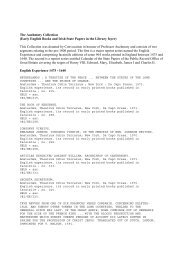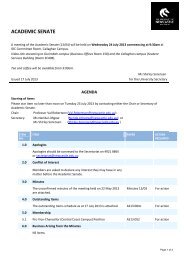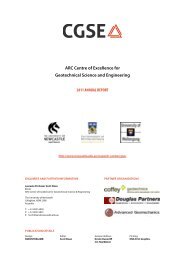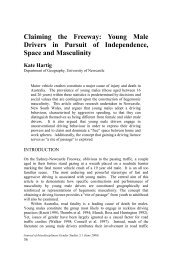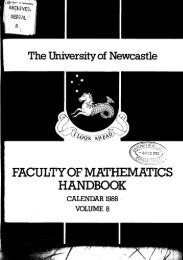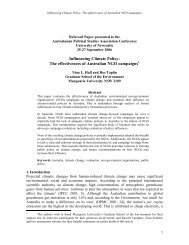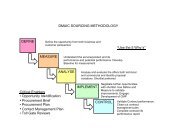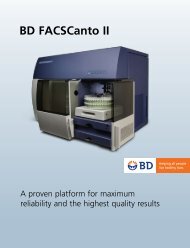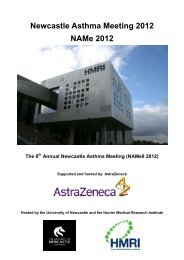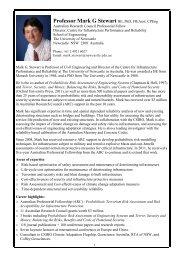Faculty of Mathematic Handbook,1987 - University of Newcastle
Faculty of Mathematic Handbook,1987 - University of Newcastle
Faculty of Mathematic Handbook,1987 - University of Newcastle
You also want an ePaper? Increase the reach of your titles
YUMPU automatically turns print PDFs into web optimized ePapers that Google loves.
Content<br />
Building on the foundation laid in <strong>Mathematic</strong>s Education II, a more thorough study is<br />
made <strong>of</strong> the psychology <strong>of</strong> learning, limits on the ability to learn and the development <strong>of</strong><br />
teaching strategies in mathematics. Assignments will require students to articulate<br />
mathematical insights they are acquiring concurrently in the academic mathematics topics.<br />
The integration <strong>of</strong> mathematical ideas from different topics will be emphasised, as this is<br />
required for effective teaching. In the observation periods, lesson plans will be studied<br />
and compared with the results in the classroom.<br />
RUSSIAN FOR THE SCIENTIST AND MATHEMATICIAN - CA. Croxton<br />
Formal enrolment in this course is not required.<br />
Prerequisite<br />
Hours<br />
Examination<br />
Content<br />
None, although familiarity with a modem language<br />
would be <strong>of</strong> advantage.<br />
Approximately 27 lecture hours<br />
None<br />
This is a voluntary course designed to give students and members <strong>of</strong> staff a working<br />
reading knowledge <strong>of</strong> scientific and technical Russian. Translation from Russian into<br />
English is costly, and only a very small proportion <strong>of</strong> the Soviet Union's technical<br />
literature is routinely translated into English: <strong>of</strong>ten translation <strong>of</strong> the abstract alone is<br />
sufficient to determine whether a complete translation is warranted. Emphasis throughout<br />
the course will be on translation from Russian into English, although both written and<br />
spoken Russian will necessarily be involved. The course should provide a good<br />
introduction for those seeking a somewhat more literary understanding <strong>of</strong> the language.<br />
112<br />
FACULTY OF MATHEMATICS RESEARCH PROGRAMMES<br />
The <strong>Faculty</strong> <strong>of</strong> <strong>Mathematic</strong>s is active in research in a wide variety <strong>of</strong> areas. Enquiries<br />
about individual research projects should be directed to the staff member(s) responsible.<br />
RESEARCH IN THE DEPARTMENT OF COMPUTER SCIENCE<br />
Artificial Intelligence<br />
Simon is working on aspects <strong>of</strong> Artificial Intelligence, with particular regard to computer<br />
processing <strong>of</strong> natural language.<br />
Computer Architecture<br />
The MONADS Research Team is investigating aspects <strong>of</strong> computer architecture which<br />
directly affect the execution <strong>of</strong> system and applications s<strong>of</strong>tware (including addressing,<br />
protection, synchronisation and support for modularity and for high level programming<br />
languages). (See The MONADS Project.)<br />
Computer Graphics<br />
Dr. Blatt is working on generative computer graphics. Improved algorithms for hidden<br />
line and hidden surface removal are being developed. Also, techniques for the generation<br />
<strong>of</strong> high qUality colour shaded images are being studied.<br />
Computer Networks<br />
The MONADS Research Team is investigating a technique for implementing local area<br />
networks involving the transfer <strong>of</strong> information in a large uniformly addressed virtual<br />
memory. (See The MONADS Project.)<br />
Computer Performance Evaluation<br />
Execution <strong>of</strong> computer programs in a system can be traced so that patterns <strong>of</strong> the<br />
references to main storage are observed. These patterns. which are <strong>of</strong> fundamental<br />
importance in determining the performance <strong>of</strong> virtual memory systems, are relatively<br />
poorly understood. Research being carried out by Dr. Blatt with Dr. Hannaford <strong>of</strong> the<br />
Department <strong>of</strong> Computer Science at Purdue <strong>University</strong>, has aimed at furthering the<br />
understanding <strong>of</strong> program referencing behaviour, with a view to developing realistic<br />
models <strong>of</strong> referencing behaviour and improved memory management strategies.<br />
Database Techniques<br />
An unconventional approach to database design is being explored by the MONADS Team<br />
which at the physical level involves the use <strong>of</strong> a virtual memory with very large unique<br />
addresses (currently 60 bits) and capability based protection and at the logical level<br />
involves the use <strong>of</strong> the LEIBNIZ language, based on sets, sequences and tuples. (See<br />
The MONADS Project.)<br />
The MONADS Project<br />
The MONADS Project is the main research project being undertaken in the Department<br />
<strong>of</strong> Computer Science. It is concerned with the investigation <strong>of</strong> a wide variety <strong>of</strong><br />
techniques for improving s<strong>of</strong>tware engineering methodology and for safeguarding the<br />
privacy <strong>of</strong> infonnation in computer systems. The theoretical research results are being<br />
embodied in a practical system consisting <strong>of</strong> the MONADS-PC computer, the MONADS<br />
Operating System and the LEIBNIZ Programming Language.<br />
113



